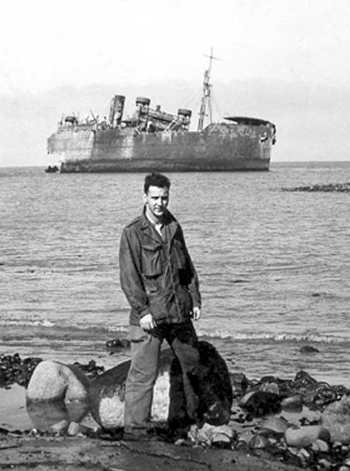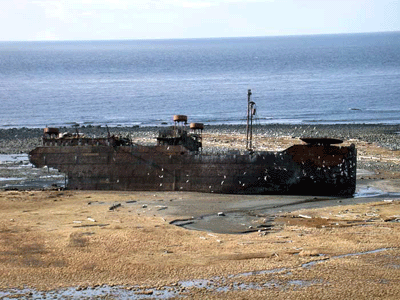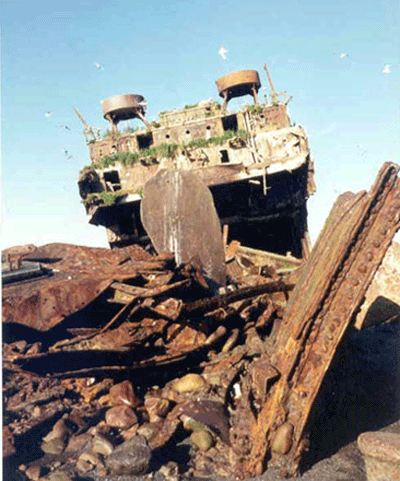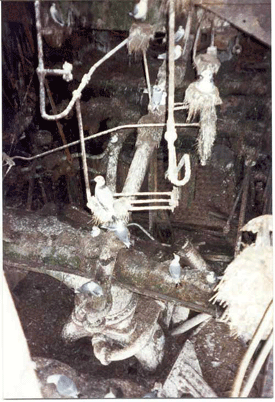Page 3 History and facts about Middleton Island
The SS Colebrook
The strange looking reamins of a ship that lies on the northwest beach of the island is the SS Colebrook. I thought the ship deserved some attention as it has become an important part of Middleton's landscape and , for the past 65 years, a day time marker beacon for pilots...Once a pilot saw the ship, they knew they were at Middleton Island. The Colebrook was built at Hog Island , PA. in 1919 and was turned over to the Federal Maritime Commission who then owned the ship until her loss, Many of these ships were built shortly after WW. l. They were commonly know as "Hog Islanders" . The sister ships of the Colebrook were known as "3-Islander Hog Islanders" because of their high well deck foward and aft of their mid-ship house. They were the equivalent of the "Liberty" and "Victory" ships built during WW2. Built from a master design with mass production methods, they were intended to alleviate the shortage of American flag merchant vessels. The cost of these ships was large and with the decline in shipping after the war, many were sold at a great loss. Others rotted while tied up at the dock.
. Very little is known about the Colebrook during the years immediately that followed her completetion in November of 1919. It is very possible that she spent a great deal of time during the early 20's tied up at some port in the east. Later on, however, she did operate on the east coast, utilizing the services of of a general agent with her actual operation carried on by the Maritime Administration, The first concrete information obtained was a record of her documentation with the Customs Dept at Philadelphia, which is listed as her home port.
This documentation. Permanent Enrollment No. 57 was issued at Philadelphia on November 15, 1938.
Her master, Capt. J.O. Story, obtained this dovument from
the Bureau of Customs at Newport News , VA. on May 4, 1939.
Since vessels under enrollment are not required to clear, the
Bureau of Customs has no idea of when he sailed or what his
destination was. On June 2nd, 1939, the Colebrook arrived in
Seattle, Washington, under tow.
At that time she was chartered to the Puget Sound Orient Line,
a company which has since gone out of business. Under their
flag, she was engaged in trade between the far east and the Pacific
northwest. On May 10th, 1940, she was bareboat chartered to
the then newly organized Americal Mail Line. At the time of the
charter the valuation of the Colebrook was in the neighborhood
of $150,000. Under the AML flag, the Colebrook continued her
trade with the Orient. She loaded lumber product, flour, grain
and other agricultural exports in the Pacific coast ports of
Tacoma, Seattle, Portland and Bellingham. She carried no
passengers. She crossed the North Pacific to Shanghai,
Hong Kong, Manila, Iloilo. Cebu, Nagoya, Shimizu and
Yokahoma, returning from there to the Pacific Northwest. The
Colebrook made six voyages to the far east for the AML. She
returned from the last in December of 1941, leaving Japanese
waters about three weeks before the war began. After the war
started the Colebrook was turned over to War Shipping Administration and was alloted to the War Department for Alaskan use. During this period, the Colebrook was armed,. She carried two deck guns, one on the bow and one on the stern. She also carried several anti aircraft, "gun tubs". While it is impossible to trace her route during the six moths prior to being lost on Middleton Island, It is known that she supplied several islands in the Aleutian chain and carried battle scars from combat action there.
One section of the ship was rigged out as a floating machine shop by one of the civilian contractors in Alaska. Morrison-Knudsen Company had access to this shop, but they were not the contractor that fitted it out. In June of 1942 the Colebrook was loaded in Seward, Alaska. The cargo consisted in part of old tires, empty rgg crates and empty coke bottles. There was also a considerable amount of meat on board.
After leaving Seward the Colebrook set course for Seattle. Some time during the night of June 2nd and 3rd she grounded on Middleton Island.
During the years since her grounding many stories have arisen as to how she happened ground here. (at Middleton Island).
Here are the four major ones; 1. She was heavily overloaded due to her cargo plus her armor plating and weapons and that her seams opened during a storm and was intentionally grounded.
No. 2; Her civilian pre-war charted holders,
the AML, were informed that she strayed off
course in a heavy fog and struck a reef.
No. 3,; According to several Alaskans,
she was struck by a torpedo and damaged
severely enough to warrant her intentional
grounding. This story was supposedly held
back for security reasons.
No. 4. Other Alaskans say she was taking
evasive action from a Japanese submarine
and struck the reef during these manuevers.
Since it is impossible to contact any
former members of the crew it is difficult to
say definitely which of these stories is the
most accurate. Since she had seen recent
combat duty in the Aleutians, it is highly
probable that she was somewhat gun shy.
Poosibly the crew thought they spotted a
submarine. Then while taking evasive
action during the darlness, she ran aground
on one of the outlying reefs on Middleton Island. The SS Colebrook, high and dry.........photo by Verena Gill
Stretching the imagination further, it is possible that she was damaged on one of the outlying rocks and the Captain, although free of the rock and still afloat, felt that the damage was severe enough to warrant her intentional grounding on the island proper. Several ships arrived on the scene the next day, including a tug and a Coast Guard vessel. That same day a Civil Aviatiot survey party arrived on Middleton to do preliminary work
for the construction of the CAA
(now FAA) station. These people were
interragated by a military party from
one of the ships. They were informed
that she ran aground while avoiding
a submarine. During the following
days considerable effort was made
to free the Colebrook. On June 8th,
Merritt Chaplin and Scott's Salvage
ship, Discoverer, arrived on the scene.
Salvage attempts were continued
with high hopes of success. On
June 13th a strong gale arose. This
moved the vessel further up on the
beach and caused further damage.
At this time it was discovered that the
bottom was badly opened and it was
decided that the ship could not be
saved. The crew was transferred to
another ship on June 14th and the
SS Colebrook was considered a
destructive total loss as of noon, June 3rd 1942, Eastern war time. Some of her portable gear was taken off at that time. During the rest of the war and the years that followed no serious salvage attempts were made. Various CAA personnel stationed here visited the ship and salvaged many portable items, as did several passing boats.
As late as 1948 the ship was still intact, although there were signs of stress and cracking just aft of the mid ships house. At that time the turbines and other machinery were still in good working condition.
Sometime after 1948 the stern of the ship broke off during a storm and drifted off to deeper water and sank. Much of the debris that broke free at that time still lies just aft of what is left. Various parties have considered salvaging all or part of the ship. One of these
was Harold Giliam, who was a pilot for
Morrison-Knudsen Co. A salvage company
working out of Seattle was interested in the
wreck at one time. All of these projects were
dropped because of the expected returns
were too low for the risks and trouble
involved. On April 5, 1954 , the
SS Colebrook was sold by the Maritime
Administration on Invitation to
Bid SP-W-54-11 . The high bidder was Ellen
Lucille Becker of Vinita, Oklahoma. There
is no record of any kind pertaing to the
Colebrook after this sale. Several
unsuccessful attemps were made to contact
her to find out what she plans to do with the
35 year old ship which had, at that time,
been wrecked for 12 years..
author D.W.at MDO.....Armand
Specifications: S.S. Colebrook
Builder:
American International Shipbuilding
Corporation, Hog Island, PA.
Commissioned: November 1919
Owner: U.S. Maritime Administration
Home Port: Philadelphia, PA.
Official Number: 219292 Radio Call; HOQK Crew 42
Length; 390 feet Beam 54.2 feet Draft 27.8 feet
Net Tons 3127 Gross Tons 5104 Deadweight Tons 7825
Propulsion 2500 H.P. Steam Turbine
Turbine, General Electric
Boilers, Babcock and Wilcox
Passenger accomodations None
Sold tp Ellen Lucille Becker, Vinita, Oklahoma
This is what is left of the engine room. This ship
makes an excellent sanctuary for the birds of
Middleton....photo by John Gavitt...




